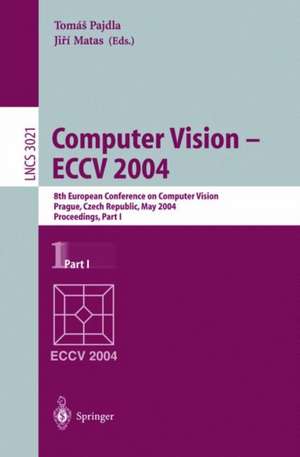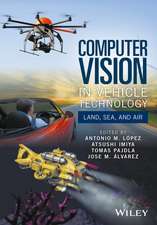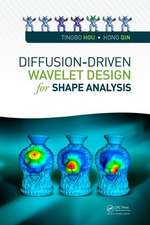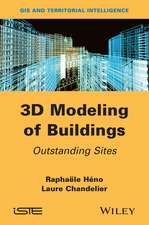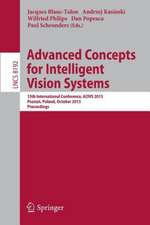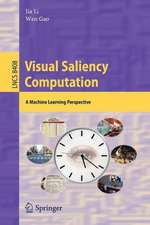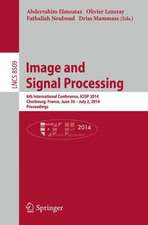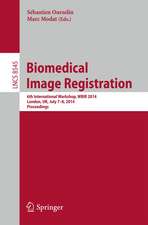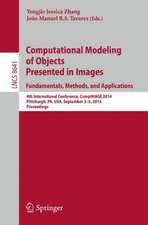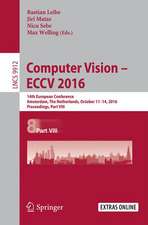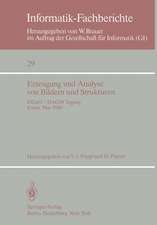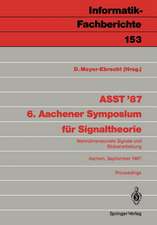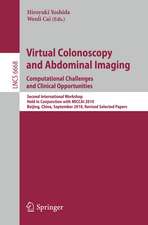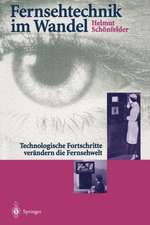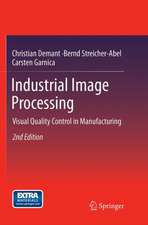Computer Vision - ECCV 2004: 8th European Conference on Computer Vision, Prague, Czech Republic, May 11-14, 2004. Proceedings, Part I: Lecture Notes in Computer Science, cartea 3021
Editat de Tomas Pajdla, Jiri Matasen Limba Engleză Paperback – 28 apr 2004
| Toate formatele și edițiile | Preț | Express |
|---|---|---|
| Paperback (4) | 627.33 lei 38-44 zile | |
| Springer Berlin, Heidelberg – 28 apr 2004 | 627.33 lei 38-44 zile | |
| Springer Berlin, Heidelberg – 30 apr 2004 | 639.01 lei 38-44 zile | |
| Springer Berlin, Heidelberg – 28 apr 2004 | 665.93 lei 6-8 săpt. | |
| Springer Berlin, Heidelberg – 28 apr 2004 | 670.22 lei 6-8 săpt. |
Din seria Lecture Notes in Computer Science
- 20%
 Preț: 1061.55 lei
Preț: 1061.55 lei - 20%
 Preț: 340.32 lei
Preț: 340.32 lei - 20%
 Preț: 341.95 lei
Preț: 341.95 lei - 20%
 Preț: 453.32 lei
Preț: 453.32 lei - 20%
 Preț: 238.01 lei
Preț: 238.01 lei - 20%
 Preț: 340.32 lei
Preț: 340.32 lei - 20%
 Preț: 438.69 lei
Preț: 438.69 lei -
 Preț: 449.57 lei
Preț: 449.57 lei - 20%
 Preț: 343.62 lei
Preț: 343.62 lei - 20%
 Preț: 148.66 lei
Preț: 148.66 lei - 20%
 Preț: 310.26 lei
Preț: 310.26 lei - 20%
 Preț: 256.27 lei
Preț: 256.27 lei - 20%
 Preț: 645.28 lei
Preț: 645.28 lei - 17%
 Preț: 427.22 lei
Preț: 427.22 lei - 20%
 Preț: 655.02 lei
Preț: 655.02 lei - 20%
 Preț: 307.71 lei
Preț: 307.71 lei - 20%
 Preț: 1075.26 lei
Preț: 1075.26 lei - 20%
 Preț: 591.51 lei
Preț: 591.51 lei -
 Preț: 381.21 lei
Preț: 381.21 lei - 20%
 Preț: 337.00 lei
Preț: 337.00 lei - 15%
 Preț: 438.59 lei
Preț: 438.59 lei - 20%
 Preț: 607.39 lei
Preț: 607.39 lei - 20%
 Preț: 538.29 lei
Preț: 538.29 lei -
 Preț: 389.48 lei
Preț: 389.48 lei - 20%
 Preț: 326.98 lei
Preț: 326.98 lei - 20%
 Preț: 1414.79 lei
Preț: 1414.79 lei - 20%
 Preț: 1024.44 lei
Preț: 1024.44 lei - 20%
 Preț: 579.30 lei
Preț: 579.30 lei - 20%
 Preț: 575.48 lei
Preț: 575.48 lei - 20%
 Preț: 583.40 lei
Preț: 583.40 lei - 20%
 Preț: 763.23 lei
Preț: 763.23 lei - 15%
 Preț: 580.46 lei
Preț: 580.46 lei - 17%
 Preț: 360.19 lei
Preț: 360.19 lei - 20%
 Preț: 504.57 lei
Preț: 504.57 lei - 20%
 Preț: 172.69 lei
Preț: 172.69 lei - 20%
 Preț: 369.12 lei
Preț: 369.12 lei - 20%
 Preț: 353.50 lei
Preț: 353.50 lei - 20%
 Preț: 585.88 lei
Preț: 585.88 lei -
 Preț: 410.88 lei
Preț: 410.88 lei - 20%
 Preț: 596.46 lei
Preț: 596.46 lei - 20%
 Preț: 763.23 lei
Preț: 763.23 lei - 20%
 Preț: 825.93 lei
Preț: 825.93 lei - 20%
 Preț: 649.49 lei
Preț: 649.49 lei - 20%
 Preț: 350.21 lei
Preț: 350.21 lei - 20%
 Preț: 309.90 lei
Preț: 309.90 lei - 20%
 Preț: 122.89 lei
Preț: 122.89 lei
Preț: 665.93 lei
Preț vechi: 832.42 lei
-20% Nou
Puncte Express: 999
Preț estimativ în valută:
127.49€ • 133.02$ • 106.87£
127.49€ • 133.02$ • 106.87£
Carte tipărită la comandă
Livrare economică 12-26 martie
Preluare comenzi: 021 569.72.76
Specificații
ISBN-13: 9783540219842
ISBN-10: 3540219846
Pagini: 668
Ilustrații: XXVIII, 640 p.
Dimensiuni: 155 x 235 x 35 mm
Greutate: 0.98 kg
Ediția:2004
Editura: Springer Berlin, Heidelberg
Colecția Springer
Seria Lecture Notes in Computer Science
Locul publicării:Berlin, Heidelberg, Germany
ISBN-10: 3540219846
Pagini: 668
Ilustrații: XXVIII, 640 p.
Dimensiuni: 155 x 235 x 35 mm
Greutate: 0.98 kg
Ediția:2004
Editura: Springer Berlin, Heidelberg
Colecția Springer
Seria Lecture Notes in Computer Science
Locul publicării:Berlin, Heidelberg, Germany
Public țintă
ResearchCuprins
Tracking I.- A Unified Algebraic Approach to 2-D and 3-D Motion Segmentation.- Enhancing Particle Filters Using Local Likelihood Sampling.- A Boosted Particle Filter: Multitarget Detection and Tracking.- Feature-Based Object Detection and Recognition I.- Simultaneous Object Recognition and Segmentation by Image Exploration.- Recognition by Probabilistic Hypothesis Construction.- Human Detection Based on a Probabilistic Assembly of Robust Part Detectors.- Posters I.- Model Selection for Range Segmentation of Curved Objects.- High-Contrast Color-Stripe Pattern for Rapid Structured-Light Range Imaging.- Using Inter-feature-Line Consistencies for Sequence-Based Object Recognition.- Discriminant Analysis on Embedded Manifold.- Multiscale Inverse Compositional Alignment for Subdivision Surface Maps.- A Fourier Theory for Cast Shadows.- Surface Reconstruction by Propagating 3D Stereo Data in Multiple 2D Images.- Visibility Analysis and Sensor Planning in Dynamic Environments.- Camera Calibration from the Quasi-affine Invariance of Two Parallel Circles.- Texton Correlation for Recognition.- Multiple View Feature Descriptors from Image Sequences via Kernel Principal Component Analysis.- An Affine Invariant Salient Region Detector.- A Visual Category Filter for Google Images.- Scene and Motion Reconstruction from Defocused and Motion-Blurred Images via Anisotropic Diffusion.- Semantics Discovery for Image Indexing.- Hand Gesture Recognition within a Linguistics-Based Framework.- Line Geometry for 3D Shape Understanding and Reconstruction.- Extending Interrupted Feature Point Tracking for 3-D Affine Reconstruction.- Many-to-Many Feature Matching Using Spherical Coding of Directed Graphs.- Coupled-Contour Tracking through Non-orthogonal Projections and Fusion for Echocardiography.- A Statistical Model for General Contextual Object Recognition.- Reconstruction from Projections Using Grassmann Tensors.- Co-operative Multi-target Tracking and Classification.- A Linguistic FeatureVector for the Visual Interpretation of Sign Language.- Fast Object Detection with Occlusions.- Pose Estimation of Free-Form Objects.- Interactive Image Segmentation Using an Adaptive GMMRF Model.- Can We Consider Central Catadioptric Cameras and Fisheye Cameras within a Unified Imaging Model.- Image Clustering with Metric, Local Linear Structure, and Affine Symmetry.- Face Recognition with Local Binary Patterns.- Steering in Scale Space to Optimally Detect Image Structures.- Hand Motion from 3D Point Trajectories and a Smooth Surface Model.- A Robust Probabilistic Estimation Framework for Parametric Image Models.- Keyframe Selection for Camera Motion and Structure Estimation from Multiple Views.- Omnidirectional Vision: Unified Model Using Conformal Geometry.- A Robust Algorithm for Characterizing Anisotropic Local Structures.- Dimensionality Reduction by Canonical Contextual Correlation Projections.- Illumination, Reflectance, and Reflection.- Accuracy of Spherical Harmonic Approximations for Images of Lambertian Objects under Far and Near Lighting.- Characterization of Human Faces under Illumination Variations Using Rank, Integrability, and Symmetry Constraints.- User Assisted Separation of Reflections from a Single Image Using a Sparsity Prior.- The Quality of Catadioptric Imaging – Application to Omnidirectional Stereo.
Caracteristici
Includes supplementary material: sn.pub/extras
